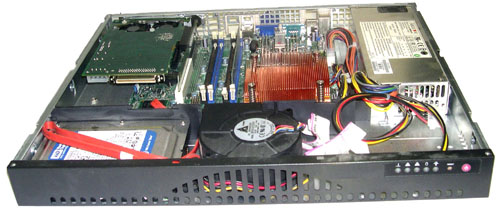1U HPC Servers for Technical Computing 1
 CIM 1U series, front-panel view
CIM 1U series, front-panel view
|
|
|
 CIM 1U series, top view, with CIM
CIM 1U series, top view, with CIMaccelerator visible at upper left |
 CIM 1U series, back panel view
CIM 1U series, back panel view
|
Overview
CIM™ 1U series HPC servers provide HPC performance in low-cost, 1U form-factors with total power consumption ranging from 200 to 300 W. These HPC servers include a dual, quad, or hex core x86 CPU and an OpenMP accelerator incorporating a CIM array. From a programming perspective, all cores -- both x86 and CIM -- appear uniform, with fine control over thread concurrency and core allocation.Applications
Applications for CIM 1U HPC servers range from intelligent video to computational finance -- wherever there is a need for high performance computing within space and energy constraints. Examples include algorithm acceleration on UAVs and robots, blade servers, private server clusters or server farms where space and/or cooling is limited, telecom racks, and more. Below is a partial list of applications areas.
|
|
|
Product Description
CIM 1U series HPC servers are designed for low-cost supercomputing applications. They minimize cost by combining mid-range Intel x86 CPUs and a very high performance accelerator. The first key to this approach is a small, low power accelerator, as opposed to large, power-hungry GPU boards. The second key is a flexible multicore programming model, instead of an API / library based approach such as CUDA. This is important because the cores in CIM series accelerators are CPU-style cores, capable of running arbitrary C/C++ code -- although heavily pipelined and containing advanced SIMD capability, they are basically similar in architecture to Intel rather than a GPU. CIM 1U series HPC servers are designed to make all cores look uniform. For example if the Intel x86 CPU contains 6 cores, and the accelerator an additional 64 cores, from a programming perspective they look the same; i.e. threads may run concurrently on all cores. Since the accelerator cores are better at numerical processing, it makes sense to designate compute-intensive source code sections to run on the accelerator, and general purpose source code sections (database, storage, user-interface, etc.) to run on x86 CPU cores.Network Support
CIM accelerators support network sockets, which means that network communication can be included in source code sections designated for acceleration. This allows longer and more complete sections of code to be marked for acceleration; one example would be voice or video transcoding, where I/O data is in the form of IP/UDP/RTP streams. In that case, it's possible to run transcoding threads on the accelerator without data "touching" the motherboard and/or Linux, further increasing throughput gains.IP Protection
Source code IP protection features include:- Binary functions
- Onboard code storage and encryption (i.e. code may be stored and/or encrypted on the accelerator)
- Decoupling from GPL and Linux-related licensing
Virtualization Hardening
Multicore resource management on CIM 1U series HPC servers is maintained on the accelerator allowing virtualization of server applications without loss in acceleration performance. For more information and theory of operation, click hereCore Allocation
OpenMP extensions supported by CIM software allow accelerator core to be allocated for (i) acceleration, (ii) task offloading, and (iii) user-defined purposes. The default is all cores allocated for acceleration. For more information and theory of operation, click here.Product Selection
Below is a product comparison guide, showing major specifications. Detailed specifications are shown in the next section.| Model |
Form- Factor |
x86 Type Speed (GHz) |
CPU Cores |
CIM Cores | Performance 2 |
Power Consumption 3 (W) |
Programming Models Supported | Cost Range (USD) 8 |
|---|---|---|---|---|---|---|---|---|
| HPC2-CIM8-1U | 1U |
Q8400 2.4 |
2 | 8 | 1G = 64 GMACS | 200 | OpenMP | 3500 - 4000 |
| 2G = 2.56 TMACS, 1.28 TFLOPS | ||||||||
| HPC4-CIM8-1U | 1U |
Q8400 2.66 |
4 | 8 | 1G = 64 GMACS | 250 | OpenMP | 4100 - 4600 |
| 2G = 2.56 TMACS, 1.28 TFLOPS | ||||||||
| HPC6-CIM8-1U | 1U |
E5645 2.4 |
6 | 8 | 1G = 64 GMACS | 300 | OpenMP | 4600 - 5100 |
| 2G = 2.56 TMACS, 1.28 TFLOPS | ||||||||
| HPC2-CIM8-1UH 4 |
1U half- width |
E2220 2.4 |
2 | 8 | 1G = 64 GMACS | 100 | OpenMP | 3500 - 4000 |
| 2G = 2.56 TMACS, 1.28 TFLOPS |
Specifications
Currently the CIM 1U series includes three (3) HPC server models, with specifications as shown below. An addition with 32 CIM cores in a single 1U server is expected in late 4Q11.Default tab content (this text) shown when (i) no tabs are automatically selected, or (ii) if rel value for the tab ="#default".
How to Purchase
NOTES1 HPC = High Performance Computing
2 Includes accelerator. TFLOPS = Tera floating point operations per second. TMACS = Tera multiply-and-accumulate operations per second. 1G card is fixed-point only.
3 Includes accelerator. W = Watt.
4 Available 4Q11
5 Available 2Q12
6 Please call for specific DIMM manufacturer and part number
7 Estimated maximum (peak) power consumption
8 Pricing subject to change without notice.



